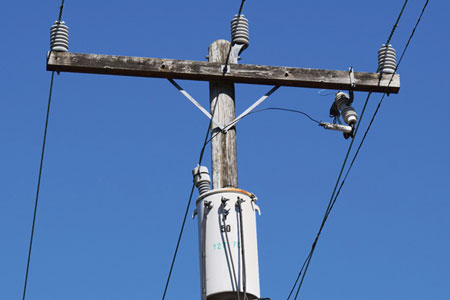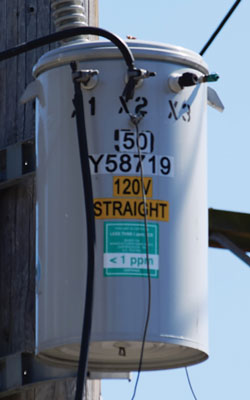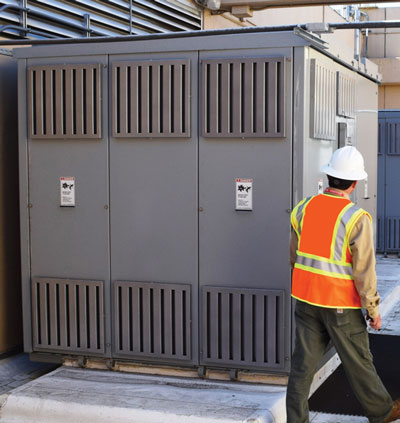
By CHRIS GREENE and TIM FRANK
Providing electrical power to our nation is a great responsibility. Despite the billions of dollars invested in electrical energy, our appetite for it is outpacing many energy providers’ ability to produce it. As our nation’s electrical infrastructure ages and demand increases, so does the potential for power disruptions resulting from chemical intrusion, line fatigue, faults, and electrical distribution systems operating beyond their capacity.
It is not uncommon for portions of a city’s electrical utility to be operating at 120 percent capacity, forcing the provider to take drastic measures to avoid damaging the equipment. An example of these measures is a “brownout.” This is a coordinated reduction of electrical service to a specific area in an effort to reduce catastrophic damage to other portions of the energy delivery system. The provider is in the business of receiving income for delivering power to the consumer. When it purposely suspends service to the customer, it is a clear sign that the demand for power is outpacing its ability to provide electrical energy in many of its areas.
Considering these trends, it is first responders’ responsibility to be familiar with the electrical equipment in their service areas and the hazards associated with the delivery equipment. Although it will be important to contact the local energy provider, conduct site visits, and have an open dialogue regarding expectations and capabilities, you first should understand some of the common components that comprise an electrical distribution system. Following is a review of some of this equipment.
High-Voltage Overhead Transmission Lines
Transmission lines are the spine of the electrical delivery system. They are responsible for moving voltages over long distances from where the power is produced to an area of demand. To move the energy over long distances, extremely large voltages are required. These lines are uninsulated and are always installed much higher from the ground than typical electrical lines. They are generally supported by large metal-framed structures, and the spans from one tower to the next are much larger than those typical for the primary lines in the vicinity of the customer.
The large voltage capacity associated with transmission lines can often create a phenomenon called “corona discharge,” which is an electrical discharge brought on by moisture in the air surrounding a conductor that is electrically charged. This is a natural occurrence in high-voltage transmission lines unless investments are made to reduce the strength of the associated electrical field. You can sometimes observe this occurring on rainy nights. Corona discharge will appear as a bluish-green gaseous discharge near the tips of the conductors. You may notice heavy radio static when you are in proximity to transmission lines; static increases with rainy weather. For consumers, this results in a brief disruption of music. However, to the energy provider, these corona discharges represent lost load potential – money that is quite literally “blowing in the wind.”
A closer look at these coronas reveals another unwanted side effect: They generate several gases such as ozone, nitric oxide, and nitric dioxide; when water is present, they create nitric acid. This produces a substance that is both toxic and corrosive. However, the levels at which they are produced and the location where they are produced (high on the tower) do not generally pose a risk for firefighters or the public under normal conditions.
 |
| (1) High-voltage overhead primary lines with a 120-volt stepdown transformer. They are typical in a residential area. (Photos by Chris Greene.) |
Substations
A substation receives power through high-voltage transmission lines. Power may arrive overhead or by an underground electrical utility conduit specifically designed for transmission lines. A substation may transform the electrical energy to a lower – more usable – level prior to sending it to areas of the city. It may also serve as a support structure, ensuring proper voltage capacity adherence for transmission lines.
These facilities are often unattended, relying on a type of remote monitoring system called “Supervisory Control and Data Acquisition” (SCADA). SCADA is software used by many industries to monitor large-scale systems from offsite locations; that is the standard for most substations.
Do not expect to find workers staffing substation facilities. Fires in these facilities are rare, but they do occur. They are extremely hazardous, and you should not enter the facility without a trained utility worker. Deenergizing the entire substation is unlikely, so fire suppression efforts should give way to a well-developed risk-benefit analysis that has received input from an onsite utility expert.
 |
| (2) This is a reconditioned pole-mounted transformer. Notice the label indicating less than one part per million of PCBs. |
Primary Lines, Secondary Lines, and Service Lines
Primary lines, secondary lines, and service lines are three types of nontransmission electrical lines used to deliver power to the customers within a city’s electrical distribution area. Primary lines have a higher voltage capacity [> 600 volts (V)] and are considered “high voltage.” Specifically, they provide for communication between substation and transformer and, in some cases, transformer to transformer.
Secondary lines carry lower voltage capacities (< 600V) and are considered “low voltage.” The lower voltage is a result of high voltage being transformed to a more useful voltage. They are used to connect transformers and private service areas and may also connect larger transformers with smaller stepdown transformers.
A service line provides power to a private user (i.e., a single-family home or high-rise building). It is the last line delivering energy from a transformer to the consumer. The final incoming voltage to the occupancy will be seen in this line – 120V for a single-family dwelling.
 |
| (3) A typical dry transformer. They may be located inside the building or on the roof. |
Transformers
A transformer is used to change (transform) electricity from low to high or high to low. However, it is more common to have a transformer that is stepping down power from high to low, making power more usable for the consumer. Multiple transformers are used along the electricity’s path from where the energy was produced to where it is used. A transformer in the vicinity of the consumer will receive its power through a large-capacity primary feeder line that has been reduced in voltage by a separate transformer located in a substation.
Transformers can be broadly categorized as oil-filled or air-cooled. They are generally situated near the end user; however, the specific locations can vary. They may be found aboveground, on a pad mount, elevated on a utility pole, inside buildings, or underneath streets and sidewalks. Utility spaces that contain a transformer are referred to as “vault spaces” or “vault rooms.”
When you locate the transformer’s access doors, they should display a placard indicating “High Voltage.” This access door is often provided with a number and symbols specific to location and equipment inside the space. The placards aid in identifying equipment within the infrastructure to the utility provider; the placards usually don’t mean much to fire department personnel who have not been made aware of their meaning through walk-throughs with the local energy providers and other utility workers.
Accessing these spaces is extremely hazardous and is not recommended without technical knowledge, skill, and equipment; this applies to underground vault spaces and in-building vault rooms. Similar to substations, fires inside these spaces are infrequent, but they are extremely dangerous when they occur. Complicating matters, these spaces are often not required to be monitored by the building’s fire alarm system and – as you would expect – sprinkler coverage in these spaces is generally not present and/or not wanted.
Vault spaces are constructed with three-hour fire-rated enclosures and are meant to contain a fire. When oil-filled transformers are present, there should be a dike at the door threshold associated with the space; this can indicate the type of transformer that was originally installed. However, the building will usually not alter the doorway when it has transitioned to an air-cooled-style transformer. (It is common for utilities to transition to air-cooled transformers because they are easier to maintain.) The fact that utilities are transitioning to air-cooled transformers is good news for the fire service because there is significantly less fuel if a fire occurs in the vault space. Conversely, there is significantly more hazard associated with a fire condition when oil-filled transformers are in the vault.
 |
| (4) Larger capacity oil-filled transformers. Generally, they are found in buildings and in street vaults. |
Askarel Fluids (PCBs)
“Askarel fluids” is a generic term used to describe a dielectric insulating fluid comprised of 50 percent polychlorinated biphenyls (PCBs), which were used historically in oil-filled transformers. PCBs were originally seen as a superior fluid for use in transformers because they offer long-term chemical stability and have a high boiling point. PCBs, although rare today, are of particular concern because they are considered environmentally nonbiodegradable. They are transdermal, accumulating in fatty deposits, and extremely difficult to remove. Inerteen and Pyranol are common trade names for PCBs. The manufacturing of PCBs was outlawed in 1979, and since then most utility companies have removed and replaced these PCBs with nonhazardous options such as mineral oil or synthetic esters.
Rectifiers
A rectifier is a device used to convert alternating current (AC) energy to direct current (DC) energy. A common use for a rectifier is to supply DC power to an overhead catenary system or power a third rail for mass transportation purposes. A rectifier will typically be accompanied by a transformer that is receiving power from a high-voltage AC source. The transformer is used to reduce the current to a level that is more easily rectified to a usable DC voltage, typically 750V for catenary systems and 1.5 kilo-volts for third-rail applications. The process of rectification from AC to DC is not a simple volt-for-volt transformation.
It is important to note that detecting energized DC equipment may require the use of detection equipment specific to DC voltage. Your standard hot-stick and stray voltage detector are not designed to detect DC voltage. If your city is served by a mass transit system that uses overhead catenary lines or a rail system with an energized third rail, it is likely supported by multiple rectifying platform stations peppered throughout its service area.
Although this is not a description of every type of electrical energy equipment, it includes the most commonly encountered equipment. There can also be significant differences between equipment in a “network” service area in critical load areas of the city (downtown, hospitals, businesses with large electrical demands, and so on) vs. neighborhoods that have the occasional medium-size apartment building and a grocery store.
Reach out to your energy provider to learn more about the specific equipment in your fire company’s response area. As our cities’ electrical systems continue to age and the demand for power increases, there will be an increasing number of failures resulting in emergencies that you will be forced to mitigate. Knowledge about how this equipment operates under normal conditions will assist you in making an educated risk/benefit analysis prior to engaging in the emergency.
CHRIS GREENE is a 21-year veteran of and a captain with the Seattle (WA) Fire Department (SFD), assigned to Engine Company 25, which is part of the Vault Fire Response Group (VFRG) stationed in the Capitol Hill neighborhood. He created the VFRG within the SFD while working closely with Seattle City Light Personnel to identify hazard gaps in fire department equipment and procedures for electrical emergencies.
TIM FRANK is an 18-year veteran of and a lieutenant with the Seattle (WA) Fire Department assigned to Ladder Company 10, which is part of the Vault Fire Response Group stationed in the Capitol Hill neighborhood. He also serves as a search manager for the Washington State FEMA Urban Search and Rescue Task Force 1.
When Electricity Takes an Unexpected Path
When Electricity Takes an Unexpected Path, Part 2
Electricity in the Air
Mitigating Electrical Hazards on the Fireground
Fire Engineering Archives

